
This is a lesson built in Desmos Classroom. It teaches about Correlation Coeffiecent using technology.
- Subject:
- Statistics and Probability
- Material Type:
- Activity/Lab
- Author:
- Jill Baldwin
- Date Added:
- 05/19/2020

This is a lesson built in Desmos Classroom. It teaches about Correlation Coeffiecent using technology.

Today we’re going to talk about data relationships and what we can learn from them. We’ll focus on correlation, which is a measure of how two variables move together, and we’ll also introduce some useful statistical terms you’ve probably heard of like regression coefficient, correlation coefficient (r), and r^2. But first, we’ll need to introduce a useful way to represent bivariate continuous data - the scatter plot. The scatter plot has been called “the most useful invention in the history of statistical graphics” but that doesn’t necessarily mean it can tell us everything. Just because two data sets move together doesn’t necessarily mean one CAUSES the other. This gives us one of the most important tenets of statistics: correlation does not imply causation.

This example walks student through process step by step.
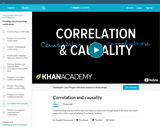
Understanding why correlation does not imply causality (even though many in the press and some researchers often imply otherwise).

An introduction and examples of how to use Correlation and Simple Linear Regression. Explaining concepts as coefficient of correlation, dependent variables, independent variables and the straight line equation and residuals.

This activity has students investigate their own cost, CO2 output, and time for commuting. They then compare their commute to an environmentally conscious alternative by using comparable metrics.
(Note: this resource was added to OER Commons as part of a batch upload of over 2,200 records. If you notice an issue with the quality of the metadata, please let us know by using the 'report' button and we will flag it for consideration.)
![Course Lecture Slides : ROTEL Project Statistics Through an Equity Lens [Revised Edition].](https://img.oercommons.org/160x134/oercommons/media/courseware/lesson/image/Cover_RotelProject_FrSU-Statistics-Anthony-RE.jpg)
These are course lecture slides that are a companion for teaching ROTEL Project Statistics Through an Equity Lens [Revised Edition]. Statistics Through an Equity Lens [Revised Edition] carries a significant responsibility by presenting statistics through an equity lens. There are 8 chapters in Statistics Through an Equity Lens [Revised Edition]. Chapters 7 and 8 are Case Studies and Hypothesis Testing. This Ancillary Resource is Course Lecture Slides for Chapters 1-6. A brief outline of the chapters’ contents follows by section.
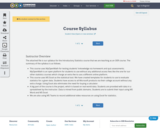
The attached file is our syllabus for the Introductory Statistics course that we are teaching as an OER course. The summary of the syllabus is as follows.This course uses MyOpenMath for testing students' knkowledge via homework and quiz assessments. MyOpenMath is an open platform for students to use without any additional access fees like the one for our other statistics courses which charge an extra fee to use a different online platform.This course uses MS Excel as the statistical tool. We have created templates for students to use to evaluate statistics for a given data. Students have access to all Microsoft products via their college account without any extra charge. Using Excel also eliminates the need for buying a calculator.A big part of the course is the project, which is based on real world data. Students are provided with data in a spreadsheet by the instructor. Data is mined from public domains. Students are to submit their input using MS Word and MS Excel.We are also using MS Teams to record additional video resources on using Excel for statistics.

This case study is based on exercises developed by Dave Pollard and uses images and mapping from Delaney and Pollard (1981). Students explore mechanisms of dike emplacement by measuring dike thicknesses along two segments of a dike intruded into shale near Ship Rock, New Mexico and mapped by Paul Delaney. Students then compare the observed dike profiles to a mechanical model -- the solution for a crack filled with magma under uniform pressure. Using the equation for opening of the crack students estimate the driving stress (difference between the magma pressure and remote principal stress acting perpendicular to the dike plane) using several different estimates of the rock stiffness parameters. Students are then asked to observe how well their best-fit model fits the two dike profiles and to investigate the map further and hypothesize why the observed widths may deviate from the simple model. Deviations from the mechanical model can lead to discussions on mechanical interaction as well as brecciation and stoping.
(Note: this resource was added to OER Commons as part of a batch upload of over 2,200 records. If you notice an issue with the quality of the metadata, please let us know by using the 'report' button and we will flag it for consideration.)

Students learn about the role engineers and mathematicians play in developing the perfect bungee cord length by simulating and experimenting with bungee jumping using washers and rubber bands. Working as if they are engineers for a (hypothetical) amusement park, students are challenged to develop a show-stopping bungee jumping ride that is safe. To do this, they must find the maximum length of the bungee cord that permits jumpers (such as brave Washy!) to get as close to the ground as possible without going "splat"! This requires them to learn about force and displacement and run an experiment. Student teams collect and plot displacement data and calculate the slope, linear equation of the line of best fit and spring constant using Hooke's law. Students make hypotheses, interpret scatter plots looking for correlations, and consider possible sources of error. An activity worksheet, pre/post quizzes and a PowerPoint® presentation are included.
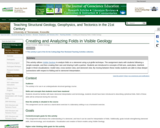
This activity utilizes Visible Geology to analyze folds on a stereonet using a pi-girdle technique. The assignment starts with students following a simple example, and then creating their own and sharing it with a partner. Students are introduced to concepts of fold axis, axial plane, interlimb angle in three-visualizations: model view, cross-section view, and stereonet view. By moving between these media students are able to draw deeper connections with respect to folding and to stereonet interpretation.
(Note: this resource was added to OER Commons as part of a batch upload of over 2,200 records. If you notice an issue with the quality of the metadata, please let us know by using the 'report' button and we will flag it for consideration.)
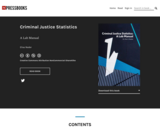
A Lab Manual
Word Count: 2702
(Note: This resource's metadata has been created automatically by reformatting and/or combining the information that the author initially provided as part of a bulk import process.)
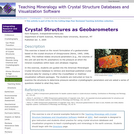
This exercise is based on the recent formulation of a geobarometer based on the crystal structure of clinopyroxene (Nimis, 1995; 1998; 1999). This method relates structural parameters (e.g., the volumes of the unit cell and the M1 polyhedron) to the pressure at which the mineral crystallizes within basic and ultrabasic magmas.
In this exercise, students are guided into the American Mineralogist Crystal Structure Database to retrieve and download published crystal structure data for viewing in either the CrystalMaker or XtalDraw visualization software packages. The students are instructed on how to examine the structures to determine pressure-sensitive crystallographic parameters and are asked a series of questions related to what they learn.
(Note: this resource was added to OER Commons as part of a batch upload of over 2,200 records. If you notice an issue with the quality of the metadata, please let us know by using the 'report' button and we will flag it for consideration.)
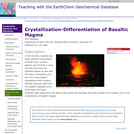
In this exercise, students use major-element compositions of whole-rocks, volcanic glasses, and minerals in lavas and drill cores from the solidified Kilauea Iki lava lake. The data is presented in the form of a "precompiled" spreadsheet which contains selected analyses culled from the GEOROC database and a USGS Open File report. Students make graphs from the data to learn about the petrologic processes related to the eruption and in situ crystallization of basaltic magma
(Note: this resource was added to OER Commons as part of a batch upload of over 2,200 records. If you notice an issue with the quality of the metadata, please let us know by using the 'report' button and we will flag it for consideration.)
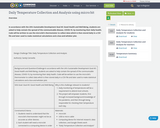
In accordance with the UN’s Sustainable Development Goal #3: Good Health and Well-Being, students are asked to help contain the spread of the communicable disease, COVID-19, by monitoring their daily health. Code will be written to use the micro:bit’s thermometer to collect data which is then stored daily in a CSV file and later used to make statistical calculations and a box-and-whisker plot.
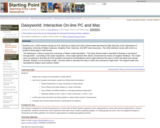
Students use a JAVA interface design by R.M. MacKay to explore the Daisy World model. The JAVA interface comes with a link to a 6-page student activity page in PDF format.
(Note: this resource was added to OER Commons as part of a batch upload of over 2,200 records. If you notice an issue with the quality of the metadata, please let us know by using the 'report' button and we will flag it for consideration.)
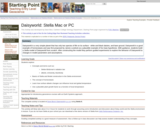
After constructing a Stella model of Daisyworld students perform guided experiments to explore the behavior of Daisyworld to changes in model parameters and assumptions.
(Note: this resource was added to OER Commons as part of a batch upload of over 2,200 records. If you notice an issue with the quality of the metadata, please let us know by using the 'report' button and we will flag it for consideration.)
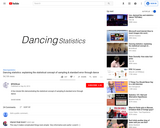
This 5:10 video illustrates the concepts of sampling and standard error through dance.
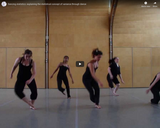
This 4:43 video illustrates the concept of variance through dance.
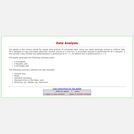
The applet in this section allows for simple data analysis of univariate data. Users can either generate normal or uniform data for k samples or copy and paste data from another source to a text box. A univariate analysis is performed for all k samples.